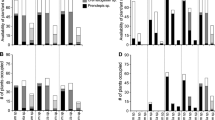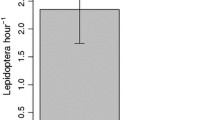Abstract
This study compares caterpillar communities (Lepidoptera and Hymenoptera sawflies) in agricultural hedgerows dominated by aggressive non-native plants (novel hedgerows) and hedgerows comprised largely of indigenous plants. It differs from controlled common garden studies because it examines the impact of evolutionarily novel plants that have replaced native plants in unmanaged ecosystems and thus provides a more accurate measure of what is happening to interactions between plants and insects in invaded natural areas. Four hedgerows of each treatment were searched methodically along 100 m transects during June and July 2011 for a seasonal total of 500 min each. Seasonal totals of species richness, caterpillar abundance, and caterpillar biomass were recorded and compared using linear mixed models. We also estimated a Lepidoptera productivity index for each hedgerow based on the plant species composition and biomass as well as literature host records for each species present. Although we found similar richness of plant species, and more plant biomass in novel hedgerows, novel hedgerows had 68% fewer caterpillar species, 91% fewer caterpillars, and 96% less caterpillar biomass than native hedgerows. Moreover, novel hedgerows were predicted to have 5.4 times less Lepidoptera productivity based on their plant composition. Interactions between caterpillars and hedgerow plants were also significantly impacted by introduced plants, with novel hedgerows supporting 84% fewer interactions between plants and caterpillars and 57% less interaction diversity than native hedgerows. This is a considerably larger impact of novel plants on a critical component of terrestrial food webs than has been measured in common garden experiments at the same location and demonstrates that plant–herbivore interactions are compromised when novel species replace resident species, even if plant species richness does not change.

Similar content being viewed by others
References
Awmack CS, Leather SR (2002) Host plant quality and fecundity in herbivorous insects. Annu Rev Entomol 47:817–844. https://doi.org/10.1146/annurev.ento.47.091201.145300
Bascompte J, Jordano P (2014) Mutualistic networks, 1st edn. Princeton University Press, Princeton, NJ
Bates D, Maechler M, Bolker B, Walker S (2014) lme4: linear mixed-effects models using Eigen and S4. R package version 1.1-7. http://Cran.R-project.org/package=lme4. Accessed 12 July 2018
Berenbaum MR (1990) Coevolution between herbivorous insects and plants: tempo and orchestration. In: Gilbert F (ed) Insect life cycles. Springer, London, pp 87–89
Bernays EA (2001) Neural limitations in phytophagous insects: implications for diet breadth and evolution of host affiliation. Annu Rev Entomol 46:703–727
Blondel J, Thomas DW, Charmantier A, Perret P, Bourgault P, Lambrechts MM (2006) A thirty-year study of phenotypic and genetic variation of blue tits in Mediterranean habitat mosaics. Bioscience 56:661–673. https://doi.org/10.1641/0006-3568(2006)56%5b661:ATSOPA%5d2.0.CO;2
Brewer R (1961) Comparative notes on the life history of the Carolina chickadee. Wilson Bull 3:348–373
Burghardt KT, Tallamy DW (2013) Plant origin asymmetrically impacts feeding guilds and drives community structure of herbivorous arthropods. Divers Distrib 19:1553–1565. https://doi.org/10.1111/ddi.12122
Burghardt KT, Tallamy DW (2015) Not all non-natives are equally unequal: reductions in herbivore β-diversity depend on plant phylogenetic similarity to native community. Ecol Lett 18:1087–1098. https://doi.org/10.1111/ele.12492
Burghardt KT, Tallamy DW, Philips C, Shropshire KJ (2010) Non-native plants reduce abundance, richness, and host specialization in lepidopteran communities. Ecosphere 1:1–22. https://doi.org/10.1890/ES10-00032.1
Cohen JE, Briand F (1984) Trophic links of community food webs. Proc Natl Acad Sci USA 81:4105–4109
Davis MA, Chew MK, Hobbs RJ, Lugo AE, Ewel JJ, Vermeij GJ, Brown JH, Rosenzweig ML, Gardener MR, Carroll SP, Thompson K, Pickett STA, Stromberg JC, Tredici PD, Suding KN, Ehrenfeld JG, Grime JP, Mascaro J, Briggs JC (2011) Don’t judge species on their origins. Nature 474:153–154. https://doi.org/10.1038/474153a
Dirr M (1998) Manual of woody landscape plants. Stipes Publishing, Champaign
Dunn J, Garrett K (1997) A field guide to the warblers of North America. Houghton Mifflin, New York
Dyer LA, Walla TR, Greeney HF, Stireman JO III, Hazen RF (2010) Diversity of interactions: a metric for studies of biodiversity. Biotropica 42:81–289. https://doi.org/10.1111/j.1744-7429.2009.00624.x
Ehrlich PR, Ehrlich A (1981) Extinction: the causes and consequences of the disappearance of species. Random House, New York
Elton CS (1927) Animal ecology. University of Chicago Press, Chicago
Farrell B, Mitter C (1990) Phylogenesis of insect/plant interactions: Have the Phyllobrotica leaf beetles (Chrysomelidae) and the Lamiales diversified in parallel? Evolution 44:1389–1403. https://doi.org/10.1111/j.1558-5646.1990.tb03834.x
Forister ML, Dyer LA, Singer MS, Stireman JO III, Lill JT (2012) Revisiting the evolution of ecological specialization, with emphasis on insect–plant interactions. Ecology 93:981–991. https://doi.org/10.1890/11-0650.1
Forister ML, Novotny V, Panorska AK, Baje L, Basset Y, Butterill PT, Cizek L, Coley PD, Dem F, Diniz IR, Drozd P, Fox M, Glassmire A, Hazen R, Hrcek J, Jahner JP, Kama O, Kozubowski TJ, Kursar TA, Lewis OT, Lill J, Marquis RJ, Miller SE, Morais HC, Murakami M, Nickel H, Pardikes N, Ricklefs RE, Singer MS, Smilanich AM, Stireman JO, Villamarín-Cortez S, Vodka S, Volf M, Wagner DL, Walla T, Weiblen GD, Dyer LA (2015) Global distribution of diet breadth in insect herbivores. Proc Natl Acad Sci USA 112:442–447. https://doi.org/10.1073/pnas.1423042112
Fox LR, Morrow PA (1981) Specialization: species property or local phenomenon? Science 211:887–893
García-Navas V, Ferrer ES, Sanz JJ (2013) Prey choice, provisioning behaviour, and effects of early nutrition on nestling phenotype of titmice. Ecoscience 20:9–18. https://doi.org/10.2980/20-1-3545
Hobbs RJ, Higgs ES (2013) Novel ecosystems: intervening in the new ecological world order. Wiley, Hoboken
Hobbs RJ, Higgs E, Harris JA (2009) Novel ecosystems: implications for conservation and restoration. TREE 24:599–605. https://doi.org/10.1016/j.tree.2009.05.012
Isaksson C, Andersson S (2007) Carotenoid diet and nesting provisioning in urban and rural great tits Parus major. J Avian Biol 38:546–572. https://doi.org/10.1111/j.2007.0908-8857.04030.x
Janzen DH (1974) The deflowering of Central America. Nat Hist 83:49–53
MacArthur R (1955) Fluctuations in animal populations and a measure of community stability. Ecology 36:533–536
Maestre FT, Quero JL, Gotelli NJ, Escudero A, Ochoa V (2012) Plant species richness and ecosystem multifunctionality in global dry-lands. Science 335:214–218. https://doi.org/10.1126/science.1215442
Morse DH (1989) American warblers: an ecological and behavioral perspective. Harvard University Press, Cambridge
Mulder CPH, Koricheva J, Huss-Danell K, Högberg P, Joshi J (1999) Insects affect relationships between plant species richness and ecosystem processes. Ecol Lett 2:237–246. https://doi.org/10.1046/j.1461-0248.1999.00070.x
Naeem S (1998) Species redundancy and ecosystem reliability. Conserv Biol 12:39–45. https://doi.org/10.1111/j.1523-1739.1998.96379.x
Naeem S, Duffy JE, Zavaleta E (2012) The functions of biological diversity in an age of extinction. Science 336:1401–1406. https://doi.org/10.1126/science.1215855
Narango DL, Tallamy DW, Marra PP (2017) Native plants improve breeding and foraging habitat for an insectivorous bird. Biol Conserv 213:42–50. https://doi.org/10.1016/j.biocon.2017.06.029
Pinheiro J, Bates D, DebRoy S, Sarkar D, R Core Development Team (2018) nlme: linear and nonlinear mixed effects models. R package version 3.1-137. http://CRAN.R-project.org/package=nlme. Accessed 12 July 2018
R Core Team (2017) R: a language and environment for statistical computing. R foundation for statistical computing, Vienna, Austria. http://www.R-project.org. Accessed 30 Aug 2017
Reich PB, Tilman D, Isbell F, Meuller K, Hobbie SE (2012) The impacts of biodiversity loss escalate through time as redundancy fades. Science 336:589–592. https://doi.org/10.1126/science.1217909
Rey Banayas JM, Newton AC, Diaz A, Bullock JM (2009) Enhancement of biodiversity and ecosystem services by ecological restoration: a meta-analysis. Science 325:1121–1124. https://doi.org/10.1126/science.1172460
Rogers LE, Hinds WT, Buschbom R (1976) A general weight vs. length relationship for insects. Ann Entomol Soc Am 69:387–389
Sax DF, Gaines SD (2008) Species invasions and extinction: the future of native biodiversity on islands. Proc Natl Acad Sci USA 105:11490–11497. https://doi.org/10.1073/pnas.0802290105
Scherrer S, Lepesqueur C, Vieira MC, Almeida-Neto M, Dyer L, Forister M, Rezende Diniz I (2016) Seasonal variation in diet breadth of folivorous Lepidoptera in the Brazilian cerrado. Biotropica 48:491–498. https://doi.org/10.1111/btp.12325
Schmitz OJ, Hamback PA, Beckerman AP (2000) Trophic cascades in terrestrial systems: a review of the effects of carnivore removals on plants. Am Nat 155:14–153. https://doi.org/10.1086/303311
Shaw JD, Spear D, Greve M, Chown SL, Fernandez-Palacios JM (2010) Taxonomic homogenization and differentiation across Southern Ocean Islands differ among insects and vascular plants. J Biogeogr 37:217–228. https://doi.org/10.1111/j.1365-2699.2009.02204.x
Simpson EH (1949) Measurement of diversity. Nature 163:688
Tallamy DW (2004) Do alien plants reduce insect biomass? Conserv Biol 18:1689–1692. https://doi.org/10.1111/j.1523-1739.2004.00512.x
Tallamy DW, Shropshire KJ (2009) Ranking lepidopteran use of native versus introduced plants. Conserv Biol 23:41–947. https://doi.org/10.1111/j.1523-1739.2009.01202.x
Tallamy DW, Ballard M, D’Amico V (2010) Can alien plants support generalist insect herbivores? Biol Invasions 12:2285–2292. https://doi.org/10.1007/s10530-009-9639-5
Thomas JA (2005) Monitoring change in the abundance and distribution of insects using butterflies and other indicator groups. Philos Trans R Soc B 360:339–357. https://doi.org/10.1098/rstb.2004.1585
Venables WN, Ripley BD (2002) Modern applied statistics with S, 4th edn. Springer, New York
Verhoeven KJF, Biere A, Harvey JA, Van Der Putten WH (2009) Plant invaders and their novel natural enemies: Who is naïve? Ecol Lett 12:107–117. https://doi.org/10.1111/j.1461-0248.2008.01248.x
Wagner DL (2005) Caterpillars of Eastern North America. Princeton University Press, Princeton
Wagner DL, Schweitzer DF, Sullivan JB, Reardon RC (2011) Owlet caterpillars of Eastern North America. Princeton University Press, Princeton
Walker BH (1992) Biodiversity and ecological redundancy. Conserv Biol 6:18–23. https://doi.org/10.1046/j.1523-1739.1992.610018.x
Zuur AF, Ieno EN, Walker NJ, Saveliev AA, Smith GM (2009) Mixed effects models and extensions in ecology with R. Springer Science, New York
Acknowledgements
We thank the University of Delaware Undergraduate Research Program for supporting M. Richard during this study, Lee Dyer for advice in measuring interaction diversity, and Kimberley Shropshire for graphics support.
Author information
Authors and Affiliations
Corresponding author
Electronic supplementary material
Below is the link to the electronic supplementary material.
Rights and permissions
About this article
Cite this article
Richard, M., Tallamy, D.W. & Mitchell, A.B. Introduced plants reduce species interactions. Biol Invasions 21, 983–992 (2019). https://doi.org/10.1007/s10530-018-1876-z
Received:
Accepted:
Published:
Issue Date:
DOI: https://doi.org/10.1007/s10530-018-1876-z




